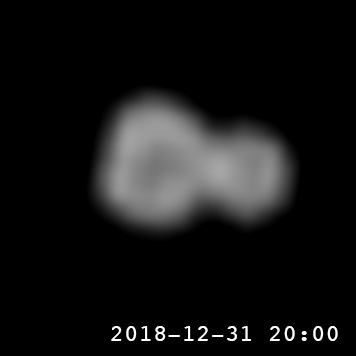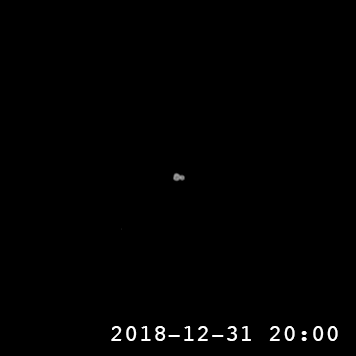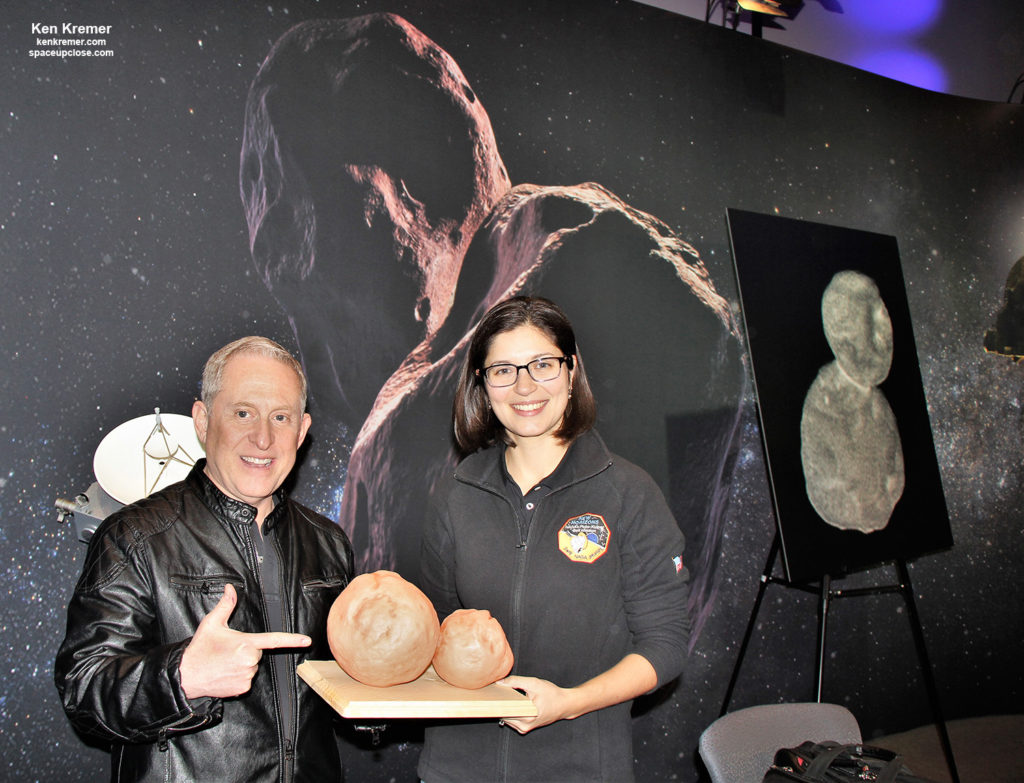Ken Kremer —SpaceUpClose.com &
RocketSTEM –15 January 2019
CAPE CANAVERAL, FL/JOHNS HOPKINS UNIVERISTY APPLIED PHYSICS
LABORATORY, LAUREL, MD – Hold on to your
seats real tight if you want to go on the ultimate wild ride on the farthest and
coldest body ever visited up close in history – namely Ultima Thule !
The ‘Snowman’ shaped primordial object was observed in close
proximity for the first time just moments after the clock struck midnight ringing in New
Year’s Day 2019 during a history making close flyby by NASA’s groundbreaking New Horizons spacecraft!
Today, Jan. 15, the science team leading NASA’s New Horizons
mission has just released a super cool rotation movie composed of images taken by
the onboard LORRI camera during the last seven hours of the probes closet approach
to Ultima Thule – located some 4 Billion miles from Earth.
Ultima Thule was discovered to be a ‘contact binary’ and counts
as the first planetesimal ever seen up close by an emissary from Earth and has
remained virtually unchanged since it formed during the birth of our Solar
System.
These are the first new images released by the team since the
last media briefing held on Jan. 3 at the Johns Hopkins University Applied
Physics Laboratory (JHU APL), in Laurel, MD – attended by Space UpClose.
Data relay from the baby grand piano shaped spacecraft was
interrupted for about a week starting on Jan. 4 as it passed behind the sun
during a period of solar conjunction which prevented radio signals from
reaching Earth.
New Horizons has now reemerged from behind the sun and resumed
data playback. It will take about 20 months to receive all the data gathered during
the super successful flyby and saved on
the data recorders.
Ultima
Thule is the most distant and most primitive object ever explored up close by a spaceship from humanity – a small icy rock in the Kuiper Belt located some 1
Billion miles (1.6 Billion km) beyond Pluto and orbits 4.1 Billion miles (6.6
Billion km) from the Sun and the Earth. So
seeing it is sort of like traveling in a time machine back to the birth of
our solar system.
The newly released rotation movie shows the
propeller-like rotation of Ultima Thule in the seven hours between 20:00 UT (3
p.m. ET) on Dec. 31, 2018, and 05:01 UT (12:01 a.m.) on Jan. 1, 2019, as seen
by the Long Range Reconnaissance Imager (LORRI) aboard NASA’s New Horizons as
the spacecraft sped toward its close encounter with the Kuiper Belt object at
05:33 UT (12:33 a.m. ET) on Jan. 1.
hours.
Horizons spacecraft flew past Ultima Thule within a distance of merely 2,200
miles (3,500 kilometers) while approaching
at a velocity of 32,000 mph (9 miles per second). It gathered about 50 GB of data including imagery,
spectroscopy and research measurements using its 7 on board science instruments.
Here is a detailed description of the movie and images from
the New Horizons team:
farthest planetary flyby in history – New Horizons’ range to Ultima Thule
decreased from 310,000 miles (500,000 kilometers, farther than the distance
from the Earth to the Moon) to just 17,100 miles (28,000 kilometers), during
which the images became steadily larger and more detailed. The team processed
two different image sequences; the bottom sequence shows the images at their
original relative sizes, while the top corrects for the changing distance, so
that Ultima Thule (officially named 2014 MU69) appears at constant size but
becomes more detailed as the approach progresses.
All the images have been sharpened using
scientific techniques that enhance detail. The original image scale is 1.5
miles (2.5 kilometers) per pixel in the first frame, and 0.08 miles (0.14
kilometers) per pixel in the last frame. The rotation period of Ultima Thule is
about 16 hours, so the movie covers a little under half a rotation. Among other
things, the New Horizons science team will use these images to help determine
the three-dimensional shape of Ultima Thule, in order to better understand its
nature and origin.
The raw images included in the movie are
available on the New Horizons LORRI website. New Horizons downlinked the
two highest-resolution images in this movie immediately after the Jan. 1 flyby,
but the more distant images were sent home on Jan. 12-14, after a week when New
Horizons was too close to the Sun (from Earth’s point of view) for reliable communications.
New Horizons will continue to transmit images – including its closest views of
Ultima Thule – and data for the next many months.
….
an unchanged fossil remnant and planetesimal formed during the dawn of our
solar system some 4.5 Billion Years ago.
Planetesimals are
the tiny building blocks from which much larger structures like moons and
planets are born by accretion of hordes of bits of matter over time.
The bi-lobal rock is shaped remarkably like a ‘snowman’ and
consists of two connected balls roughly spherical in appearance.
The new world measures 19 miles (31 kilometers) in length.
The team has unofficially nicknamed the larger sphere “Ultima” (12
miles/19 kilometers across) and the smaller sphere “Thule” (9
miles/14 kilometers across).
Watch
for Ken’s continuing coverage of New Horizons and prior reporting direct from JHU
APL.
Watch
for Ken’s continuing onsite coverage of NASA, SpaceX, ULA, Boeing, Lockheed Martin,
Northrop Grumman and more space and mission reports direct from the Kennedy Space
Center, Cape Canaveral Air Force Station, Florida and Wallops Flight Facility,
Virginia.
Stay tuned here for Ken’s continuing Earth and Planetary science
and human spaceflight news: www.kenkremer.com –www.spaceupclose.com – twitter
@ken_kremer – email: ken at kenkremer.com
Dr. Kremer is a research scientist,
journalist and photographer based in the KSC area.
Ken’s photos are for sale and he is available for lectures and outreach events







